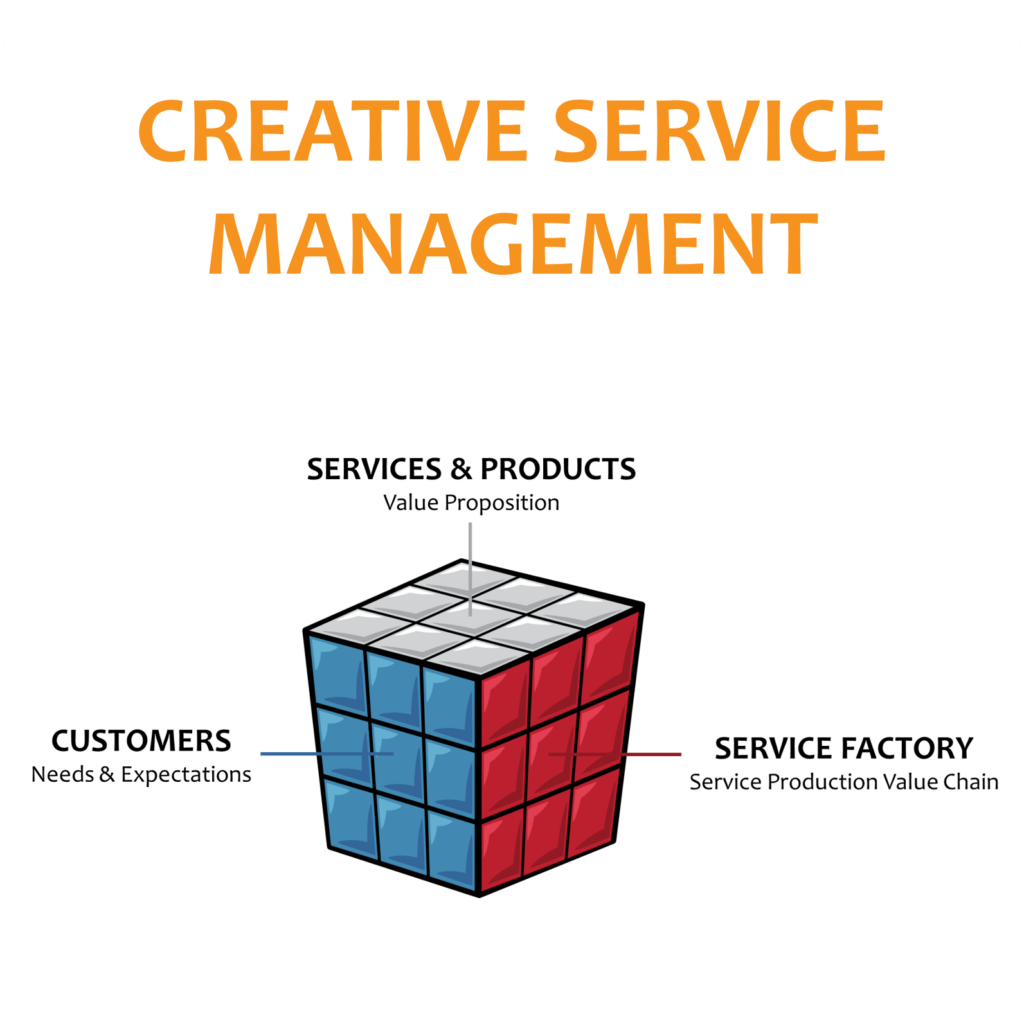
WELCOME TO CREATING BETTER SERVICES!
Creative Service Management is a mindset and toolbox for organizations that want to develop their services in a holistic and sustainable way.
It combines service management, service design, and agile methods into an integrated approach that supports the design, delivery, and development of services and products. The Creative Service Management approach provides structure for understanding what services consist of, how they should be described, and how to ensure they genuinely support customer and business needs
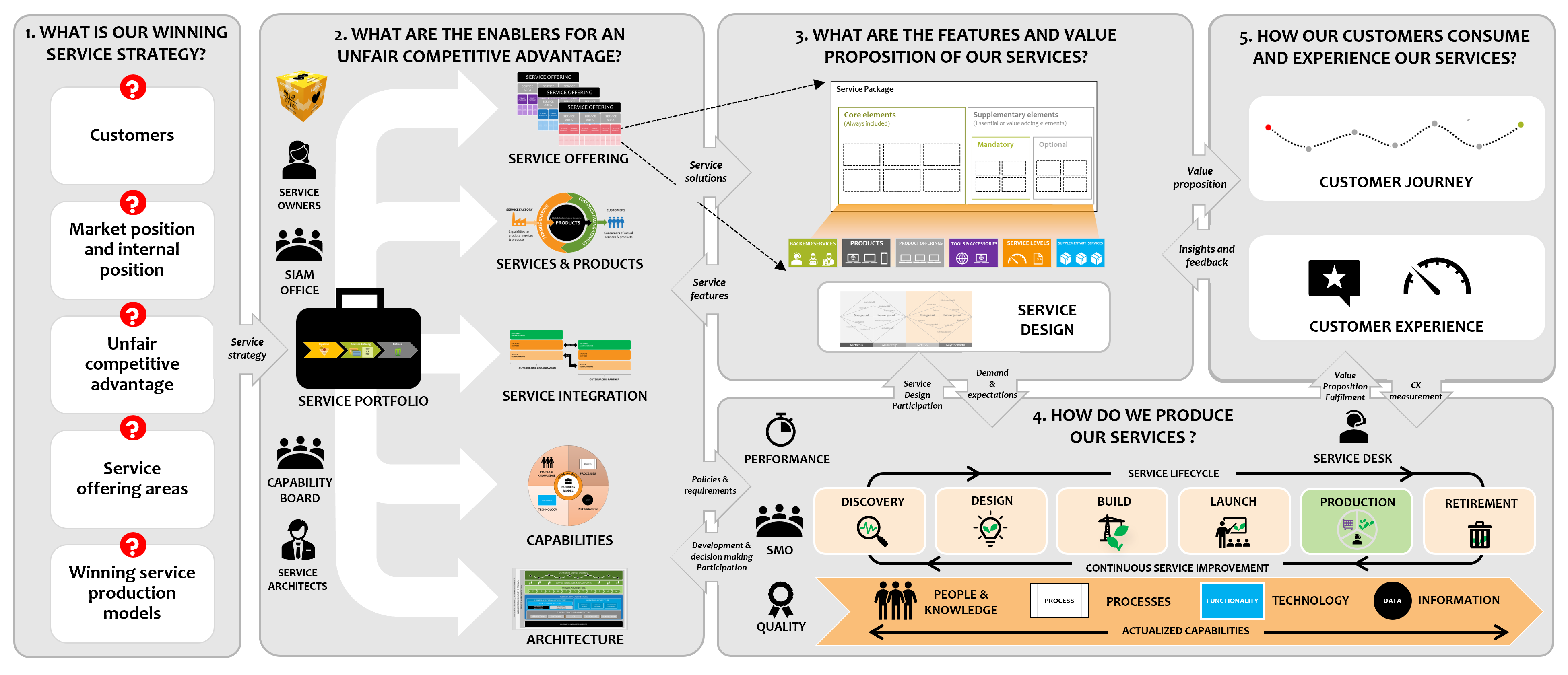
Services & products
The service model of Creative Service Management consists of three main components:
1️⃣ Customer Facing Services (CFS) are service solutions that are built upon the backend services and products they include. These services are delivered directly to customers, which can be either internal business functions or external customer organizations.
2️⃣ Backend Services (BES) are intangible internal services of the service provider that are part of customer-facing solutions or otherwise enable their production. The typical purposes of backend services include the production, delivery, and support of services and products.
3️⃣ Products are digital, technological, or other consumable products that are delivered to the customer as part of a Customer Facing Service or utilized in some way, such as a tool or resource, in service production.
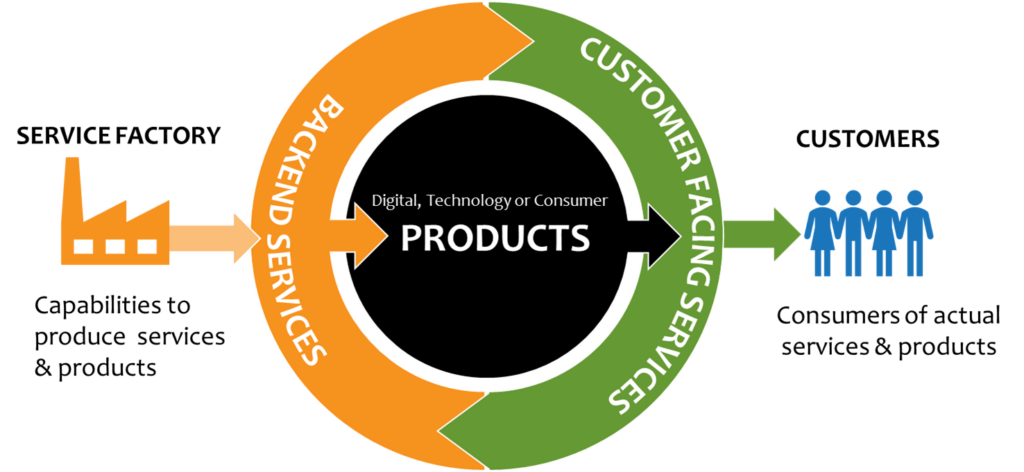
In essence, Customer Facing Services are designed to meet customer needs by integrating the necessary backend services and any required products. It can be said that backend services and products are wrapped into a Customer Facing Service before they can be delivered to the customer.
© Justin Group Oy 2025 | All rights reserved.
Service offering
In the service offering, the service provider defines the services it delivers, either for its internal needs or for its customers. The offering outlines the service domains it includes, the service products within those domains, and the service packages associated with each service product.
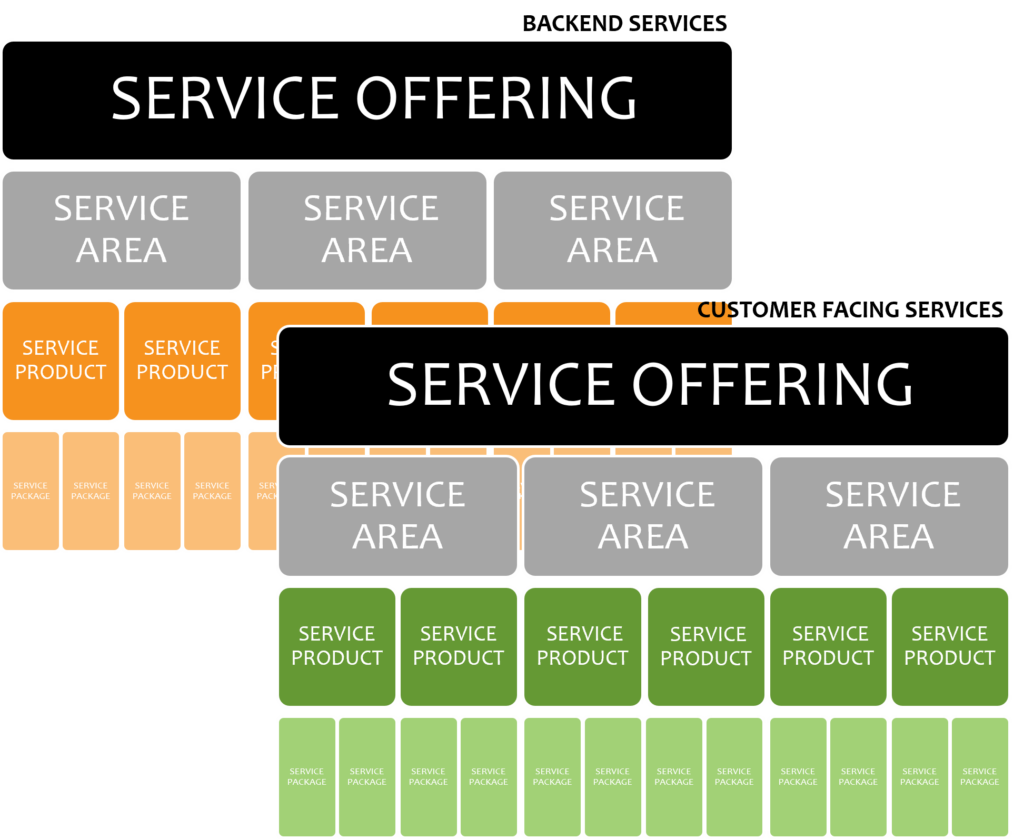
Logically, every service provider has at least two types of services:
1️⃣ Backend Services and the portfolio of internal services they form.
2️⃣ Customer Facing Services and the portfolio of external services they form.
© Justin Group Oy 2025 | All rights reserved.
Capabilities
The implementation of operational and business models requires organizations to possess specific types and levels of capabilities. These capabilities are critical competitive and success factors for organizations. As a result, there is a need and pressure to develop these capabilities. (JHS 179 Enterprise Architecture Design and Development, 2017).
An organization’s capabilities can be either its own or those of its partners. Capabilities can be defined and grouped in various ways. In formative service management, there are five capability areas:
- People and Knowledge
- Processes
- Technologies
- Information
These four capability areas are guided and managed according to the fifth capability, which is the chosen Operational model, ensuring the support of the desired business models.
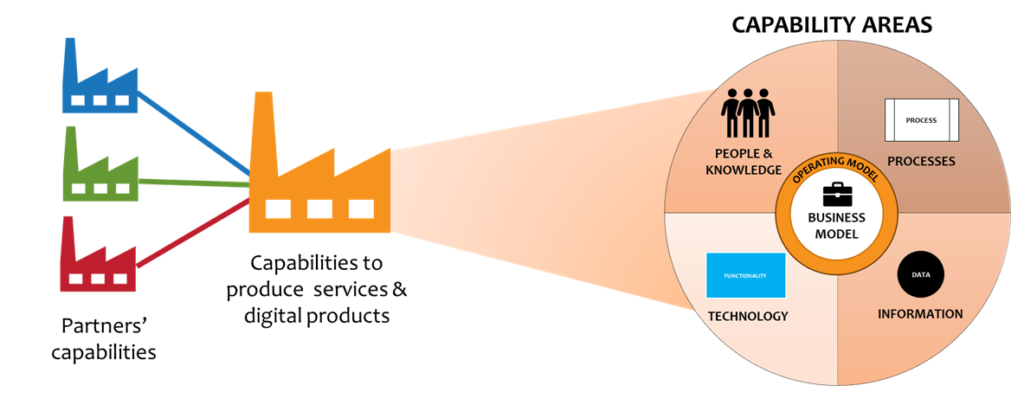
Capabilities enable flexible and adaptive operations in various situations. They foster the ability to innovate and create a competitive advantage over competitors, establish a broad resource base to support operations, and reduce risks associated with business activities.
© Justin Group Oy 2025 | All rights reserved.
Architecture
Maximizing the utilization of capabilities in the service factory requires architectural management at multiple levels. The functionalities embedded in various technologies and information systems are tools for processes, enabling them to efficiently process, utilize, and share information. This, in turn, allows them to fulfill their essential role in service production.

Figure: The Different Levels of Architecture as Enablers of Service Production
Managing architecture within an organization is not an easy task. The environment and its related concepts are multidimensional and complex. Justifying the investments required for development can sometimes be challenging, as the benefits are often indirect, materializing only after years, or related to operational continuity and risk management—topics that may not capture widespread interest and do not promise quick wins or immediate benefits for the organization.
Architecture can also be seen as a description of a value-generating mechanism. In the illustration below, the top section represents customer service journeys and the interaction points between us and the customer—elements that are typically identified and improved through service design. Services are produced through efficient processes, supported by technologies, information, and skilled people. Therefore, architecture is seamlessly linked to a great customer and service experience, directly impacting an organization’s business competitiveness and success.

Figure: Architecture as a Value-Generating Mechanism
© Justin Group Oy 2025 | All rights reserved.
Service portfolio
Organizations must have the means and tools to implement their strategy effectively. This is where the service portfolio and its dedicated management process, service portfolio management, come into play. The service portfolio is perhaps the most critical tool in service business management, as it governs the development, publication, and retirement of services.
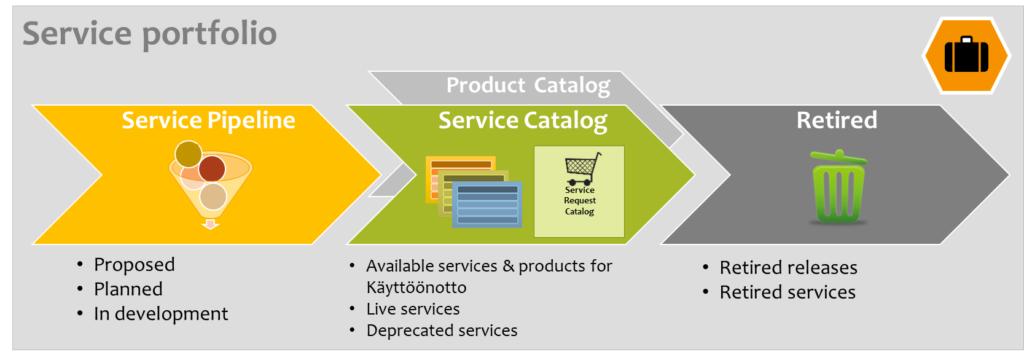
The service portfolio provides visibility and control over the following phases of the service lifecycle:
-
- Service ideation and development (development pipeline)
-
- Published services and their key performance indicators (service catalog)
-
- Controlled retirement of outdated services (decommissioning)
The service portfolio management process defines the necessary governance models, roles, tasks, and tools for managing the portfolio effectively.
© Justin Group Oy 2025 | All rights reserved.
Six Perspectives of Service Management
As with all things, customer-centric service management involves multiple perspectives. In formative service management, these perspectives are represented as a cube, with each of its six sides representing a different aspect of service leadership, development, and delivery.
The cube can be rotated and viewed from only a few perspectives at a time. However, successful and sustainable service organization management requires consideration of all six perspectives. This means that it is essential to examine things from multiple viewpoints to ensure a comprehensive understanding and effective decision-making.
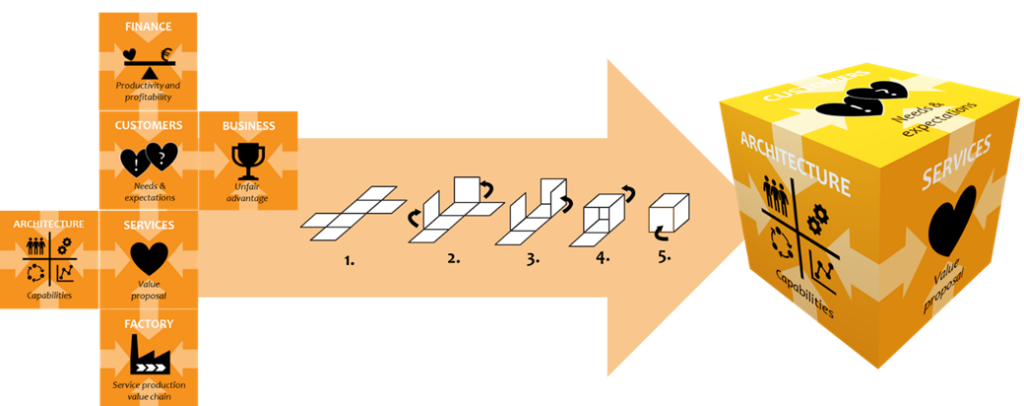
Perspective 1: Customers
Without customers, there are no services, products, or business. The purpose of service delivery is to meet customer needs and expectations while creating value. In many cases, providing services and products is also a business relationship between the service provider and the customer.
Perspective 2: Services
By defining the services and products they offer, service providers establish a value proposition, explaining how they create value for their customers. At the same time, they set expectations—both for customers and their own service production.
- What can customers expect from us?
- What is required from us to meet those expectations?
Perspective 3: Business
Service delivery is a business activity, or at the very least, the services provided support business operations or other organizational functions. Developing business competitiveness and profitability must be balanced with enhancing customer experience, performance, and quality.
Perspective 4: Service Factory
Service production requires resources and capabilities to deliver services and products in alignment with the promised value proposition. The service factory represents the operational capacity and efficiency behind service delivery.
Perspective 5: Architecture
The role of architecture is to ensure that the service provider has identified the necessary capabilities for producing and delivering services and products. In practice, this means a deep understanding of and continuous improvement in:
- People and partners
- Operating models
- Technologies
- Information
Perspective 6: Finance
Operations must be financially sustainable. At the same time, developing services and capabilities requires investment. Profitable service production depends on transparent revenue, cost, and financial management to ensure long-term viability.
Service strategy
When discussing service strategy, we can think of it as taking a step forward from business strategy in the refinement of strategy. Service strategy requires business strategy as its foundation, but at the same time, business strategy alone does not provide sufficient answers to what kind of service and product offerings the company believes will attract customers.
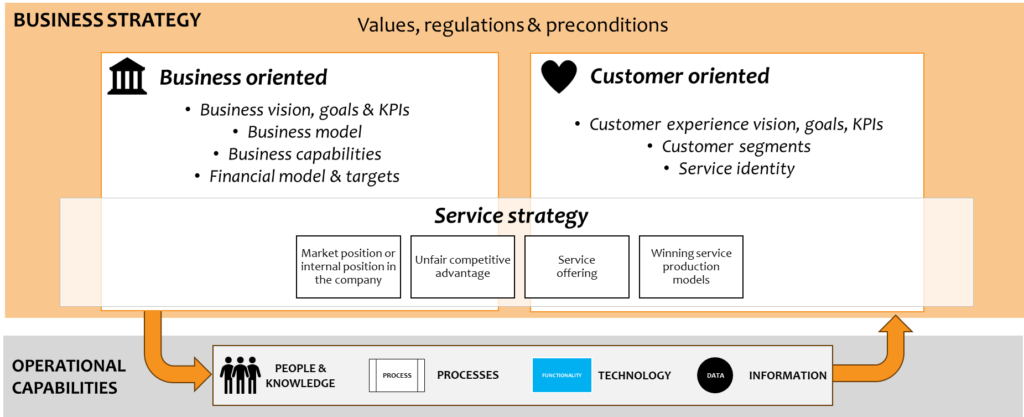
In service and product-based business, the service portfolio can also be referred to as the offering. It represents the services or products a company provides, much like a product catalog in a furniture store.
As part of the service strategy, a company must define the offerings that it believes will create competitive advantage, attract customers, increase revenue, and help achieve business goals. The service strategy guides the company’s service and product development, ensuring that services and products align with current business objectives. Additionally, it defines key aspects such as critical partners and subcontractors for service delivery, constraints and conditions for service production, and products used within the services.
© Justin Group Oy 2025 | All rights reserved.
Customers
Customer segmentation is a critical part of service development because it helps to identify the specific needs and expectations of different customer groups. By leveraging segmentation, a company can develop and tailor services to better meet the requirements of each group, enhancing the customer experience and increasing the competitiveness of its services.
Why is segmentation important in the service development?
Targeted service design: Different customer groups may require different solutions. Segmentation helps identify these differences, enabling more precise service development.
Efficient resource allocation: Knowing what the preferred customer segments desire the most, enables the company to allocate resources to fulfil those needs.
Innovation and personalization: Service concepts based on segment-specific needs facilitate the creation of innovative and personalized solutions that differentiate the company from competitors.
Optimized marketing communication: Understanding the characteristics of different segments allows for more targeted and relevant marketing messages.
Different customer types
Customers have different roles that influence how they perceive delivered services and their characteristics. It is the service provider’s responsibility to identify these roles and ensure that the delivered services meet the needs of different customer roles.
The term “customer” can therefore refer to several different roles:
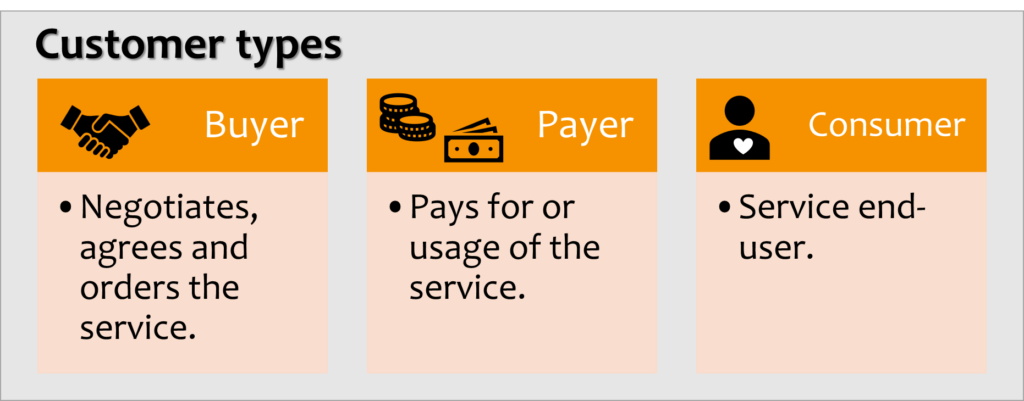
© Justin Group Oy 2025 | All rights reserved.
Position
Market position refers to the position of company’s services in the market compared to its competitors’ services, and how this positioning is reflected in both service design and management. It is a strategic concept that influences both external marketing efforts and internal development processes.
Internal position
Service providers are organizations with the necessary capabilities to deliver value to their internal or external customers through various services.
These providers can broadly be classified into two categories:
Internal Service Provider – Delivers services to its own organization, operating under its management and aligned with its strategic objectives.
External Service Provider – Provides services as a business to organizations outside its own company.

Unfair advantage
The factors that differentiate a company—or are expected to differentiate it—from competitors and enable the creation of so-called unfair competitive advantage. These can include, for example, a lower price than competitors, a higher-quality product, or a significantly better service concept.
Service offering areas
Recognizing and outlining service areas helps to structure the service offering clearly and with strategic intent.
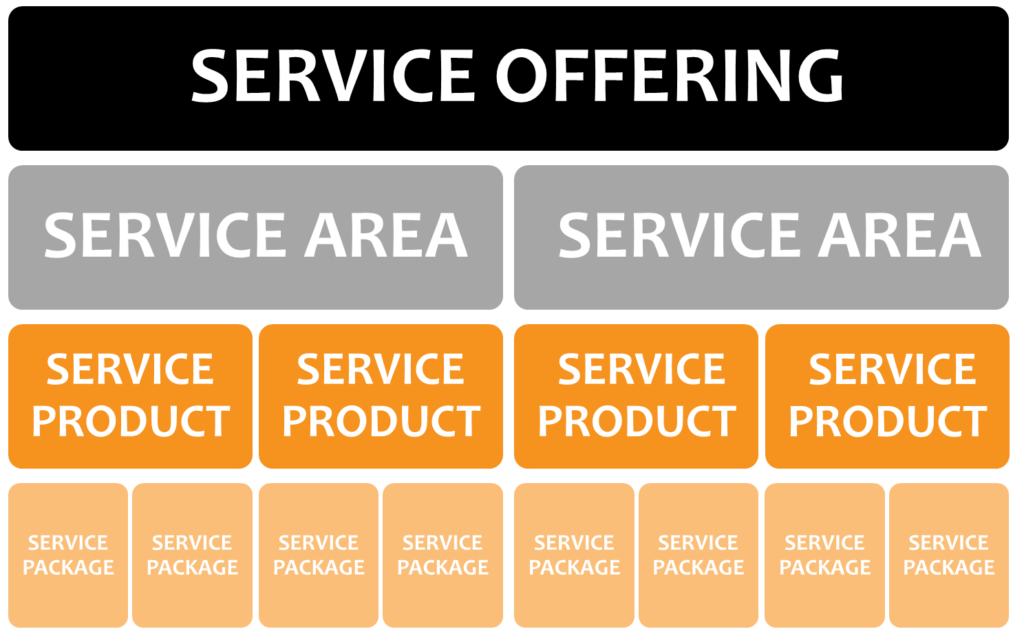
This typically includes the following topics:
Analysis of the Current State
- What services does the organization currently offer?
- How are these services distributed across different customer needs and business areas?
- Are there overlaps or gaps in the service portfolio?
Considering the Customer Perspective
- How do customers perceive the services?
- Which services support their business processes and objectives?
- Can the services be grouped in a way that aligns with customer needs?
Defining Service Areas
- Services are categorized based on their nature, purpose, and target audience.
- For example, in IT services, service areas may include infrastructure services, application management and end-user services.
Strategic Importance of Service Areas
- Which service areas are critical for competitiveness?
- Where is development or innovation needed?
- Which services act as key differentiators in the market?
Winning service production models
An organization’s operating model describes how it implements its strategy and achieves its goals in daily operations and service production. It defines the structure, operating models and principles, resources, and ways of working that enable the organization to create significant competitive advantage and deliver value to its customers and other stakeholders. The operating model serves as the practical execution of both the business strategy and the service strategy.
Service integration
In service integration, the service-providing organization combines the services required by the customer into a cohesive, easily accessible, and effortlessly usable whole. The service provider acts as an integrator, bringing together both its own services and those offered by partners into a seamless service ecosystem, ensuring their smooth interoperability and delivering a frictionless user experience for the customer.

The service packages within a service offering consist of intangible backend service elements and products, which are provided either by the organization itself or its partners. As a result, defining and packaging services is already a form of service integration, but it involves much more than that. Operational models between partners and data exchange between information systems also require integration to ensure a seamless service experience.

© Justin Group Oy 2025 | All rights reserved.
Capability board & architects
It is quite common for the management of different areas of architecture to be fragmented and uncoordinated, resulting in decision-making and development often taking place informally alongside daily work and operations. This leads to several challenges:
-
- Decisions and agreed solutions are not properly documented.
-
- Decisions are made in isolation, making it difficult to assess their impact on the overall architecture.
-
- Decision-making is slow or overly dependent on individuals, as there is no common forum for architecture governance and leadership.
-
- Architecture-related guidelines and policies are unclear and poorly communicated.
A lack of structured architecture governance can result in uncontrolled costs, increased security risks, and a poor customer and employee experience.
To address this, designated lead architects should be responsible for different architecture domains, collaborating with system, process, and service owners to oversee planning, development, and decision-making in their respective areas. A regularly convening Service Architecture Board or Capability Board can serve as a collaborative platform for key stakeholders, ensuring centralized coordination and governance of architectural work.
© Justin Group Oy 2025 | All rights reserved.
Service solutions
The service solutions within a service offering are value-generating combinations of services and, when applicable, the products delivered alongside them. They are designed to meet a specific logical customer need and can be provided to customers as standalone entities.
Each service solution is assigned an owner, categorized under a service category, and linked to a cost center where its financial figures are allocated. The detailed content and features of the service are described in its versions, known as service packages.

The development and management of a service solution is the responsibility of its owner, who is accountable for the solution and all its associated service packages.
© Justin Group Oy 2025 | All rights reserved.
Service features
As a result of service design and packaging, a clear understanding of the different versions of a service solution, known as service packages, emerges. These packages define the core elements of the service, their features, and the value proposition for customers. This structured approach makes the overall service landscape easier to grasp, supporting both internal development efforts and external communication.

Precise definition and documentation of service packages enable effective communication across various stakeholders, including sales, marketing, customer service, and production. This information helps tailor messaging for different customer segments, highlight the added value of the service, and differentiate it from competitors. Additionally, service packages play a key role in pricing model development, customer journey design, and customer experience optimization.
When service packages are systematically structured, their use in sales and marketing becomes significantly more efficient. This allows for the creation of targeted sales messages, the clear presentation of offerings to customers, and the scalable adaptation of services to different needs and target groups.
© Justin Group Oy 2025 | All rights reserved.
Policies & Requirements
Service production rarely happens in a vacuum. Policies and requirements refer to the collectively agreed principles, rules and constraints that define the conditions under which services can be designed, developed and delivered. They set the boundaries for action — but at the same time, they enable controlled innovation and development.
Key sources include:
-
Legal and regulatory requirements (e.g. data protection, accessibility, security regulations)
-
Internal policies and governance principles (e.g. sustainability, risk management, quality)
-
Service level requirements (e.g. response times, availability, capacity)
-
Standards and frameworks (e.g. ISO/IEC 20000, ITIL, TOGAF)
-
Architectural principles and technology requirements, ensuring consistency and maintainability
-
Defined services in the service portfolio and their related requirements (e.g. purpose, target groups, criticality, cost structures)
💡 On the other hand, the available capabilities in service production define what can realistically be expected or required from services. If capabilities are insufficient to meet the requirements, they must be developed to achieve the goals.
Guidelines, policies and requirements serve as both constraints and strategic drivers — creating a continuous tension between expectations and capabilities.
© Justin Group Oy 2025 | All rights reserved.
Development & decision making participation
Service Production Participation in Development and Decision-Making
In Creative Service Management, development is not a separate expert function — it’s a collaborative and inclusive process that brings together different perspectives and areas of expertise, especially from service production.
Service production participation means that development is not carried out in isolation from operations, but together with those who produce the services. This ensures that solutions are feasible, can be realistically delivered, and will become part of daily operations.
Key forms of participation:
-
Involving production teams and experts in planning and decisions
-
Active role of service owners in steering and prioritization
-
Customer and user involvement in development and evaluation
-
Joint workshops, pilots and testing – development happens by doing
-
Executive support and decision-making at the right level
Participation doesn’t mean that everyone decides everything — it means that the right people are involved at the right time and in the right role. This leads to better commitment, higher quality decisions, and early identification of risks and opportunities.
© Justin Group Oy 2025 | All rights reserved.
SIAM Office
The SIAM Office is a key function especially in multi-vendor environments, where multiple service providers deliver different parts of an overall service. The goal of SIAM (Service Integration and Management) is to integrate these services into a cohesive whole to ensure service quality, consistency, and manageability.

Typical responsibilities of a SIAM Office include:
-
Coordinating and integrating vendor collaboration.
-
Managing partner interfaces and processes.
-
Managing shared service level agreements with partners.
-
Monitoring and optimizing the performance of integrated service ecosystems.
-
Managing incidents and problems in a multi-vendor environment.
© Justin Group Oy 2025 | All rights reserved.
Service Owners
A Service Owner is responsible for ensuring that a service meets both business and customer needs — comprehensively and throughout its lifecycle. Service ownership is not just an administrative role, but an active and strategic responsibility that combines customer insight, delivery realism, and a development mindset.
A Service Owner:
-
Understands the purpose and target state of the service
-
Is accountable for service quality, continuity, and cost-effectiveness
-
Ensures the service evolves with changing needs
-
Acts as a bridge between customers, operations, and management
-
Participates in development and prioritizes change initiatives
© Justin Group Oy 2025 | All rights reserved.
Service Management Office (SMO)
The Service Management Office (SMO) is a centralized service management competence center within the service provider organization. It plays a critical role in ensuring that all internal service delivery models support the strategy, are consistent, and reflect both customer and business needs and expectations. The SMO is responsible for harmonizing service management practices across the entire organization.
The role of the SMO can vary in scope — it may focus purely on operational coordination, or it may include more strategic responsibilities, such as aligning service management practices with organizational goals and driving transformation.
SMO Role & Activities:

Typical responsibilities of the SMO include:
-
Improving and optimizing the quality, efficiency, and effectiveness of delivered services
-
Applying best practices in service management
-
Ensuring the principles of continuous improvement are embedded across the organization
-
Defining common and shared practices and operating principles for the service provider organization
-
Acting as the central governance and escalation point for service management
-
Serving as a forum for communication and collaboration
-
Supporting autonomous team models while defining common principles and guidelines for consistent service management
© Justin Group Oy 2025 | All rights reserved.
Quality
Quality is not just a metric — it is the customer’s experience in relation to their expectations. In Creative Service Management, quality is built on collaboration, continuous evaluation, and relevance.
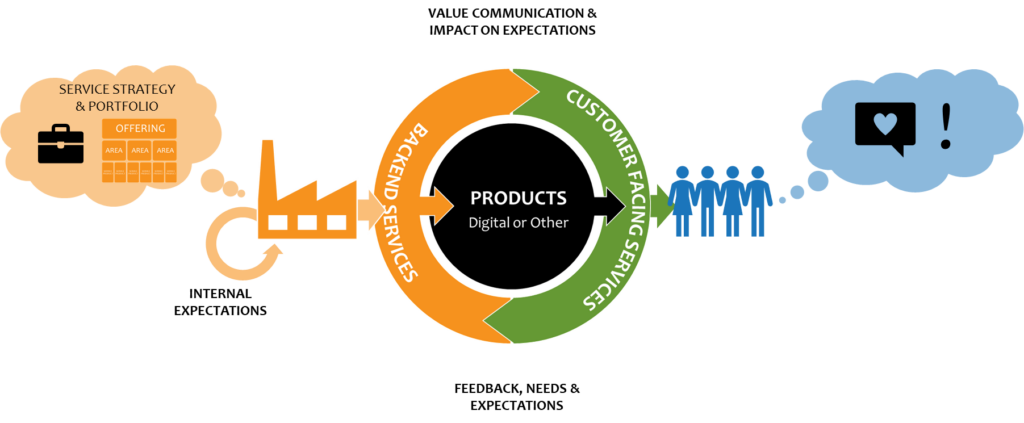
Quality management isn’t just about minimizing errors. It’s about:
-
Ensuring real customer value is delivered — doing the right things, not just doing things right
-
Designing, delivering, and developing services with quality in mind from the start
-
Using agreed criteria and metrics to guide decisions and actions
-
Collecting and acting on feedback systematically
-
Continuously adjusting the level of quality to match changing needs and expectations
© Justin Group Oy 2025 | All rights reserved.
Performance
Performance in Creative Service Management is about more than meeting SLAs — it’s about ensuring that services create real value and that delivery is sustainable, adaptive, and continuously improving.
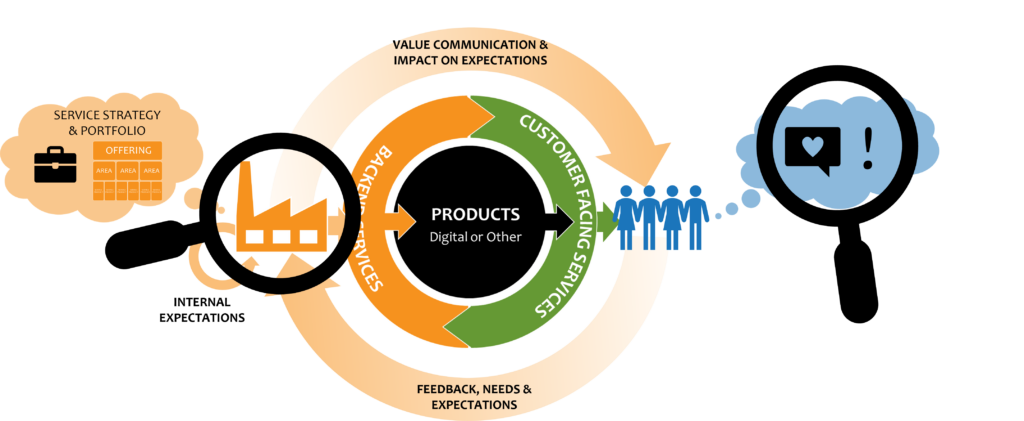
Effective performance management includes:
-
Defining what good looks like — based on customer expectations and strategic goals
-
Using relevant and balanced indicators — both quantitative (e.g. response time, availability) and qualitative (e.g. user satisfaction, perceived value)
-
Visualizing and sharing performance data to support decision-making
-
Tracking trends and patterns rather than isolated events
© Justin Group Oy 2025 | All rights reserved.
Service design participation
In Creative Service Management, service design is not just the responsibility of customers or developers — service production plays a key role as well. Their participation ensures that services are not just ideas, but are actually feasible, scalable, and workable in practice.
Participation means, for example:
-
Involving production teams early, not just during implementation
-
Bringing in operational realities: resources, technical constraints, process limitations
-
Co-designing together with customers, developers, and service operations
-
Evaluating prototypes and solutions from the production perspective
-
Refining ideas into concrete, deliverable operating models
© Justin Group Oy 2025 | All rights reserved.
Demand & expectations
Service production must ensure it has the capabilities to deliver the services defined in the service offering. Service descriptions and service packages form the basis for customer expectations, and in turn, responsibilities for service operations.
This means that:
-
Defined services and their characteristics guide the actions of service production
-
Service packages determine what is delivered to the customer, to what extent, and under what conditions
-
Service levels (SLAs) provide concrete metrics for quality and responsiveness
-
Operations must identify capability, capacity, and resource requirements to fulfill the service promise
-
Any gaps between expectations and capabilities must be made visible and addressed openly
© Justin Group Oy 2025 | All rights reserved.
Service Desk
The Service Desk is not just a support point — it is the first point of contact for the customer experience, a source of real-time insight, and a key interface between service operations and the user. Service Desk plays an active role in service improvement, feedback collection, and understanding real-life usage situations.
Key aspects include:
-
Conveying customer messages, feedback, and needs to the service organization
-
Supporting users in their daily situations — quickly and empathetically
-
Identifying recurring patterns and surfacing improvement opportunities
-
Collaborating closely with the rest of service operations, not operating in isolation
-
Helping ensure that services work as intended
© Justin Group Oy 2025 | All rights reserved.
Value proposition fulfilment
When service production has the right capabilities and readiness, it can deliver the services promised in the service offering — reliably and consistently. This is the operational foundation of value creation.
However, fulfilling the value proposition doesn’t automatically mean the customer’s actual needs are met. The service offering may have been designed based on incorrect assumptions or outdated expectations. Therefore Operational excellence enables value delivery — but doesn’t guarantee perceived value.
© Justin Group Oy 2025 | All rights reserved.
Customer experience (CX) measurement
To understand whether services truly meet customer needs, it’s not enough to measure delivery performance alone — we must also track the customer’s actual experience.
CX measurement provides insight into:
- Whether the service matches expectations in real use
- What elements of the service create value — or frustration
- How services should evolve to better support the customer’s goals
By systematically collecting and using CX data, service organizations can continuously adjust offerings and stay aligned with real, evolving customer needs.
© Justin Group Oy 2025 | All rights reserved.
Service lifecycle
While delivering, operating, maintaining, and supporting services are all important, each represents only a specific phase along the service factory path. Effective service management covers the entire service lifecycle — from the first idea related to the service all the way to its retirement.

In some organizations, the service lifecycle is not recognized or managed as a whole. This can lead to various issues, such as:
-
Poor service quality experienced by customers
-
Daily friction and inefficiencies for service teams
-
Decreased performance and delivery speed
-
Delays in onboarding and implementation
-
General deterioration in service consistency and outcomes
At its core, full-lifecycle service management is about ensuring smooth, uninterrupted communication and collaboration across all stakeholders involved in the service.
© Justin Group Oy 2025 | All rights reserved.
Continuous Service Improvement
Continuous Service Improvement (CSI) ensures that services don’t stand still — they evolve based on feedback, performance data, and changing needs.
CSI involves:
- Regularly reviewing service performance
- Identifying improvement opportunities
- Prioritizing and implementing changes in a controlled way
Each new or improved version of a service or product goes through the full service lifecycle — from discovery to retirement.
© Justin Group Oy 2025 | All rights reserved.
Discovery
In this lifecycle phase, customer needs, requirements, and market trends are gathered and analyzed. The goal is to create a foundation for service ideation and strategic direction.
© Justin Group Oy 2025 | All rights reserved.
Design
In this lifecycle phase, ideas are transformed into actionable services, products, and features, which form the basis for defining concrete development tasks.
© Justin Group Oy 2025 | All rights reserved.
Build
In this lifecycle phase, service & product versions are built and prepared for operational use. The goal is to ensure a smooth handover and readiness for continuous production.
© Justin Group Oy 2025 | All rights reserved.
Launch
In this lifecycle phase, services are published in the service catalog, marketed to customers, and communicated to internal stakeholders.
© Justin Group Oy 2025 | All rights reserved.
Production
In this lifecycle phase, services are delivered to customers as agreed. Continuity is ensured through operations & maintenance, support, monitoring, and change management.
© Justin Group Oy 2025 | All rights reserved.
Retirement
In this lifecycle phase, a service or its version is systematically taken out of use. Customers are transitioned to alternative solutions, and service relationships are formally closed.
© Justin Group Oy 2025 | All rights reserved.
Actualized Capabilities
Actualized capabilities are the concrete, operational abilities of the organization — the combination of people, processes, technologies, and information that enables the delivery of services as defined.
© Justin Group Oy 2025 | All rights reserved.
People & Knowledge
The people can be viewed and understood as the capabilities and capacity required for business and service delivery. However, people are not robots or consumable assets subordinated to business needs — they are thinking and feeling individuals, and the most valuable resource of any organization.
Through innovation, continuous development of services and operations, and by leveraging other capabilities, people enable the smooth and high-quality delivery of services, enhancing the organization’s performance and competitiveness.
The personal abilities of individuals — their knowledge, skills, and experience — are the organization’s true treasure. With the right kind of leadership and care, these human capabilities can be transformed into better services, better business, and more satisfied customers.
© Justin Group Oy 2025 | All rights reserved.
Processes
A process is a series or collection of activities that interact to achieve a desired outcome. While processes are typically repeatable, some may occur only once.
Processes form part of the core operational capability of an organization. When well-designed and aligned with goals, they create structure, consistency, and predictability in service delivery.
But processes alone don’t create value — it’s people who bring them to life, adapt them, and improve them. By combining structured workflows with human insight, organizations can ensure services are delivered efficiently, reliably, and responsively.
© Justin Group Oy 2025 | All rights reserved.
Technology
Technologies can form the core of the service we deliver to customers — often described as product elements within service packages. But beyond that, technologies — including various devices, systems, platforms, and applications — are also essential capabilities for any service organization.
The ability to perform tasks, monitor operations, and generate insights is deeply dependent on the availability and functioning of the right technologies. Whether you’re working with spreadsheets, submitting expense reports, writing proposals, logging incidents, or invoicing customers — you need fit-for-purpose tools to get the job done.
© Justin Group Oy 2025 | All rights reserved.
Information
Information and data are foundational capabilities of any service organization. They enable effective operations, smooth service and product delivery, and informed decision-making.
Data is the raw material of information processing — it can be numbers, symbols, or observations that may hold little meaning on their own. Information emerges when data is structured, analyzed, or presented in a meaningful context. It’s this transformation that allows us to understand, decide, and act.
Data is typically stored in system databases or other media in various formats. The core challenge for any service provider is to organize, maintain, and manage critical data so that it is:
-
Available when needed
-
Accurate and up to date
-
Usable in different operational and analytical contexts
© Justin Group Oy 2025 | All rights reserved.
Service design
Service design is the intentional and collaborative process of shaping services to meet user needs, business goals, and operational realities — all at once.
It’s not just about how a service looks, but how it works, how it’s delivered, and how it feels to use. Good service design ensures that:
- The service creates value for the customer
- It is feasible to deliver with available capabilities
- It is aligned with strategic and operational objectives
Effective service design brings together customers, service owners, production teams, and technologists to co-create services that are usable, viable, and desirable.
© Justin Group Oy 2025 | All rights reserved.
Service packaging
Service packaging is the process of structuring and combining service elements into coherent, understandable service packages offered to the customer. It’s a key part of service design and modeling, where abstract service ideas are translated into deliverable, usable, and marketable units.
In Creative Service Management, packaging involves:
-
Identifying and defining core & supplementary service elements, such as products, backend services and tools & accesories
-
Grouping elements into service packages that align with customer needs, expectations, and usage contexts
-
Making services clear, repeatable, and scalable — both for the customer and for production
A well-structured service package enables a shared understanding across business, production, and customer interfaces. It also forms the basis for service catalog entries, SLAs, and delivery planning.
© Justin Group Oy 2025 | All rights reserved.
Value proposition
The value proposition is the promise of value that a service offers to the customer — not just what the service does, but why it matters.
In Creative Service Management, the value proposition is formed through well-designed and packaged services, where each service is described in a way that clearly communicates:
- What the service enables for the customer
- How it solves a problem or creates benefit
- What makes it usable, reliable, or even unique
Service descriptions, combined with thoughtfully assembled service packages, turn abstract ideas into tangible, understandable, and credible value promises.
© Justin Group Oy 2025 | All rights reserved.
Insights and feedback
Customer insights and feedback are essential inputs in service design and packaging. They help ensure that services are not only technically sound, but also relevant, usable, and valuable in the customer’s real-world context.
This means:
- Observations, experiences, and feedback are collected continuously through multiple channels
- These insights inform service design decisions, from individual elements to the full package structure
- Feedback loops enable teams to adapt, improve, or reposition services as customer needs evolve
By listening carefully and translating insights into action, organizations can design services that resonate with users and meet expectations more effectively.
© Justin Group Oy 2025 | All rights reserved.
Customer Journey
The Customer Journey outlines the phases of a service from the customer’s perspective. These phases are called service moments. The purpose of mapping the service journey is to give the service a clear structure and to enable deeper examination of the customer experience at each service moment.

Within a service moment, the following aspects can be identified:
- Challenges experienced by the customer
- Customer emotions and reactions
- Touchpoints
Touchpoints are the channels, environments, and people through which the customer interacts with the service provider during service moments. Touchpoints can be divided into three types:
- Social (e.g. interaction with staff or other customers)
- Physical (e.g. facilities, printed materials)
- Digital (e.g. websites, apps, chatbots)
© Justin Group Oy 2025 | All rights reserved.
Customer experience
Customer experience is the customer’s personal interpretation of their interaction with a service. It is shaped by expectations, past experiences, emotions, and the context of the situation — making it unique and subjective.
CX is built from:
- Impressions – memory-based images that influence expectations and recall
- Encounters – physical, digital, or emotional moments of interaction
- Emotions – feelings that strongly impact perception and satisfaction
The experience doesn’t start or end with the service moment alone — what happens before and after matters just as much.
© Justin Group Oy 2025 | All rights reserved.
About Creative Service Management
There is a wide range of best practices and standards available to support service management — not to mention the tools offered by service design and agile methodologies.
But how do we build a coherent approach from all these recommendations and options that truly supports an organization in delivering services and products successfully and running a business based on them? What exactly are services made of? How should services be described in a way that is clear, complete, and useful way for across teams, customers, and partners?
Creative Service Management seeks to answer these questions by combining experience-based service management knowledge with proven service design methods. Around this core concept developed by Justin, a diverse selection of guidelines, templates, trainings, tools, and methods has been built.
The symbol of Creative Service Management, the CSM cube, represents the complexity of designing and delivering high-quality services that meet customer needs and expectations profitably: when you change one side of the cube, it inevitably affects the others. This makes service development and related operational models a complex challenge, one that Creative Service Management is designed to help organizations tackle.
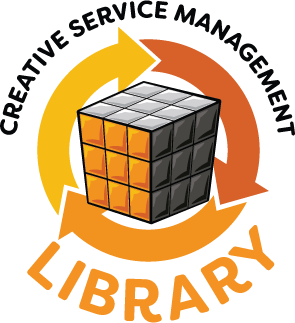
The content and document templates in the CSM Library are practical, proven tools — the same ones Justin’s consultants use in their client engagements.
All materials are published under the international Creative Commons Attribution-NonCommercial-ShareAlike 4.0 license and are available for free download from Justin’s webshop justinshop.fi.
If you’re interested in extending the permitted use beyond the standard license — for example, for commercial use — please contact us.
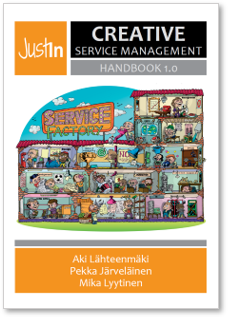
The purpose of the Creative Service Management Handbook is to serve as an aid and information source for people working with service development, leadership and management.
It provides practical instructions and tips on taking advantage of widely known practices, technologies, and frameworks in service production. This book is written completely here at Justin, and our experts use it as an internal documentation while working on our wide range of customer projects.
The book is available for purchase from justinshop.fi as a watermarked personal PDF copy.

Justin’s Creative Service Management trainings dive deeper into different areas of Creative Service Management with a practical approach – led by Justin’s experienced experts in service management and design.
Justin’s Aamukahvit (Morning Coffee) is a monthly webinar series that takes an approachable look at current topics in service management, development, and digitalization. The one-hour sessions are easy to fit into your schedule and provide inspiration and fresh ideas for Justin’s followers and professionals in the field.




























